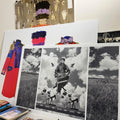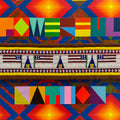Molly Murphy Adams beadwork featured in "Reservation Dogs" and "Killers of the Flower Moon"
By Medicine Man Gallery on

Molly Murphy Adams corn husk bag. Courtesy of the artist and Missoula Art Museum
When Molly Murphy Adams (b.1977; Great Falls, MT, descendant, Oglala/Lakota) moved from Montana to Tulsa 13 years ago she could never have expected it would lead her to Hollywood. She didn’t go to Hollywood as much as Hollywood came to her.
Tulsa and eastern Oklahoma were critical filming and production locations for both the FX hit TV series “Reservation Dogs,” and the Martin Scorsese-directed movie “Killers of the Flower Moon” starring Robert DiNiro and Leonardo DiCaprio. Adams provided beadwork for both projects. What, specifically, she produced, couldn’t have been more different.
In Season 1, Episode 4 of “Reservation Dogs,” a comedy with dramatic elements centered on four Native teens living on a reservation in Oklahoma, one of the main characters, Bear, wants to purchase a gift for his deadbeat rapper dad who’s returning to the reservation from Los Angeles to give a performance. Bear comes up with the idea of a beaded medallion. The only local bead worker the group knows is a character named Auntie B.
One ridiculous trait runs through all of Auntie B’s beadwork medallions. What the show needed to reflect Aunti B’s signature style couldn’t be purchased off the shelf. They needed to be custom made.
Having asked around Tulsa among the beadwork artists without finding anyone interested in creating bespoke medallions for the show, “Reservation Dogs” set designer Tafv Sampson’s (Muscogee Creek) aunts pointed her in the direction of Adams. Sampson was skeptical Adams would be interested as most of her work is geared towards museum exhibitions like the presentation on view now through January 8, 2024, at the Missoula Art Museum “Molly Murphy Adams: The Space Between.”
“(Sampson) came to me and she said I've gone to some other people, and they've been unwilling to do something that's irreverent like this,” Adams remembers. “They told (Sampson) they only bead what the Creator tells them to bead and I said, ‘the Creator’s telling me to bead some dicks!’”
All of Auntie B’s medallions in the show are outrageously, hilariously, obviously phallic, although she doesn’t see them that way.
“The joke was that (show producer) Sterlin Harjo (Seminole and Muscogee) had one of these made a while ago and he always thought it would be funny to work into a show, but then he said, ‘you know what would be really funny, if there's a bunch of them,’ like everything this character beads ends up accidentally looking phallic,” Adams explained.
She produced 10 phallic, beaded medallions on short notice including the microphone with coiled cord piece Bear intends to gift his father which features prominently in the episode.
“It was funny for people in the community to see beadwork, but also humor and that kind of irreverence,” Adams said. “For the next season I said, ‘can I do the feminine version?’ So, in Season 2, it was a lot of a lot of fruits, a lot of papaya, I did a pair of Huckle-boobies, I did a teepee that had enormous smoke flaps with a glowing light coming through the teepee hole. It was really fun to lean in and go, ‘how could I make this as funny as possible?’”
Auntie B’s beaded medallions are one example of what made “Reservation Dogs,” which concluded its third and final season this fall, such a critical and popular success. Yes, it approached serious subjects including teenage suicide, but it also spotlighted the beautiful joy and bonds in Native communities and families. And Native humor, an aspect of Native American life left out of storytelling focused on colonization, genocide and broken treaties.
“Native people laugh a lot,” Adams said. “Everybody who thinks Native people are just super stoic is missing out. The cackling is contagious.”
Seriously, Though
Adams learned beadwork as a young girl from her mother’s side of the family growing up on the Flathead Reservation amongst the Confederated Salish and Kootenai Tribes in northwestern Montana.
“I learned to be able to make the things I needed for powwow outfits, regalia,” Adams said. “Especially back then you could not just buy it anywhere. Later, when I went to art school, I started to combine this aesthetic that I knew, this way of making things that I knew, with all the things I was learning getting a fine arts degree.”

Molly Murphy Adams diptych. Courtesy Missoula Art Museum
While Adams had no hesitation in producing Auntie B’s absurd medallions, she wanted the show to take the representation of a bead worker seriously.
“After I realized we were going to do these medallions, I came back to Tafv and I said I know this sounds like I'm being very melodramatic here, but let me help design the space that this bead worker is going to work in because if people go to her house and it's just a clean table and that's it, that's a missed opportunity,” Adams remembers. “For Native people, we know who bead workers are in our community, we know what it looks like where they work, we know how we get these pieces, and you have to go negotiate with them and work it out. If this is the only time I ever see a bead worker represented and it doesn't look right, I'm going to be disappointed that I missed the opportunity to say something.”
Adams provided “Reservation Dogs” with a list of supplies every bead worker would have to include in the scene. She also let them borrow a bunch of stuff from her studio.
“(Auntie B’s beadwork table) was busy and cluttered and had trays of beads and old film containers filled with stuff and spools of thread and different size scissors so it looks like what it would look like,” Adams explained. “Growing up, everyone I knew worked around a table, a kitchen table. Big trays, cafeteria trays so they could put stuff up on top of the fridge or out of the way away from kids. That was the serious side; I know this character is silly and funny, but this one small part of it is not silly and I really hope it looks right.”
“Killers of the Flower Moon”
Unlike “Reservation Dogs,” everything about “Killers of the Flower Moon” is serious. The film adaptation of David Grann’s book by the same name brings to light the Reign of Terror which befell the Osage Nation in Oklahoma when oil was discovered on the reservation in the 1920s, transforming the Osage, overnight, from poverty into millionaires.
Scorsese demanded the film’s production pursue a meticulous, borderline fanatical attention to detail in representing the Osage, their dress, the setting, and period. Tribal members and historians had input into all of it.
For the movie, Adams reproduced a pair of beaded vests in the prairie, Otoe, Kaw style from historic photos. They feature a distinct white outline and abstracted botanical elements on navy wool.
She also worked on items featured in the Osage parade scene.
“The Osage have as a society called the War Mothers and you're only allowed to make and wear these War Mothers’ blankets if you are a mother of a service person. A lot of these are for deceased persons who died in battle,” Adams said. “It was something that was formulated during World War I as a new version of an older style of ceremony… and they have huge beaded American flags motif, eagle motifs on the back, 18-inches-wide, and they would often have the person's name, rank and branch of service, and then smaller elements going up the front like smaller American flags in vertical rows.”
Due to the sacred nature of the blankets, cultural restrictions exist around their public display.

Detail of Molly Murphy Adams beadwork. Courtesy Missoula Art Museum
“That was a process of negotiating, the movie with the cultural consultants that the tribe had authorized the movie to have – tribal go-betweens – and then the tribal community and the tribal museum,” Adams explained. “The community said we want these represented, but we can't use the real ones. The museum said as long as you're going to do it respectfully, then we are happy to open up the collection to you and you can come look at the originals that are a part of our collection. The consultants said we want to go hard and make these as real as possible – use vintage beads, do it directly onto the wool, don't do these as patches and sew them on later – so that the wearers, when they put them on, would feel like the real thing.”
This required a tremendous amount of additional work when compared to completing the beaded designs as patches and applying after the fact, but that would have resulted in the items hanging differently when worn.
“The backs of them that had the massive 15- to 18-inch-wide American flags didn't make it (into the movie),” Adams said, laughing to mask her disappointment. “I watched the movie and I went, ‘oh my god, they had me do the backs of those and they only showed the front.’”
To learn more about Osage involvement in the production of “Killers of the Flower Moon” and the filmmaker’s attention to historic detail, listen to the “Art Dealer Diaries” podcast with episodes featuring Osage elder Billie Ponca and trade blanket expert Barry Friedman.



